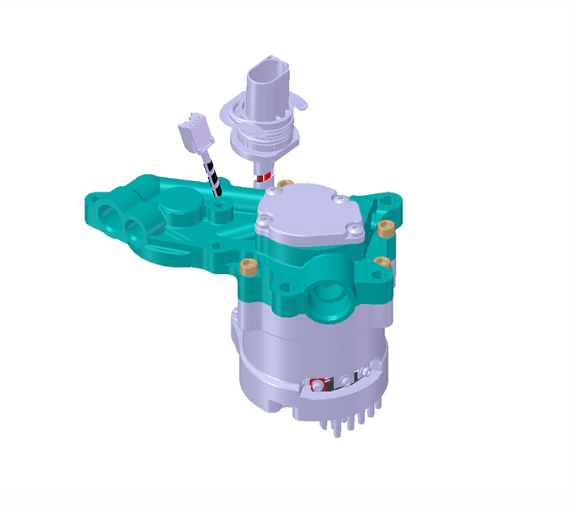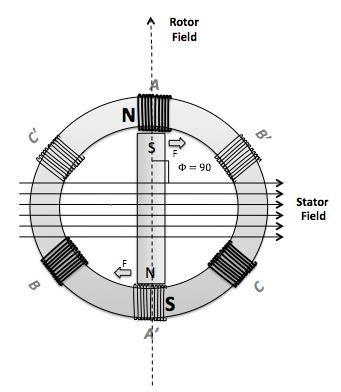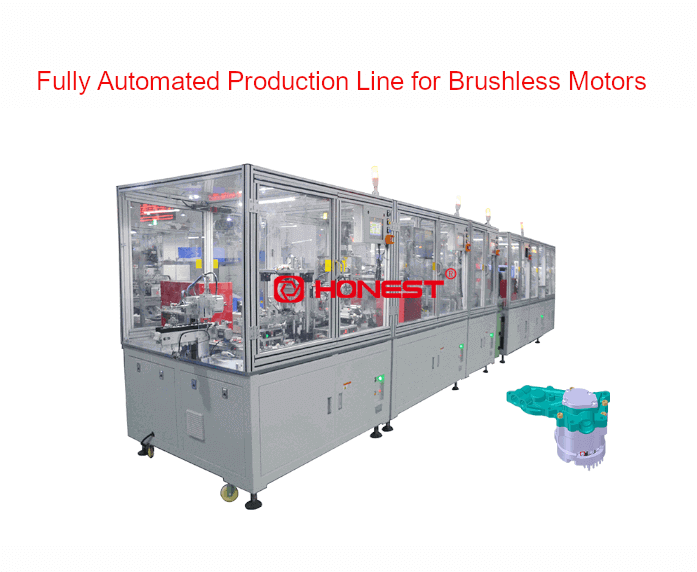Brushless Direct Current (BLDC) motors replace mechanical commutators with electronic commutations, thus incorporating the excellent speed control characteristics of DC motors with the simple structure, spark-free operation, reliability, and ease of maintenance typically associated with AC motors.
A.Working Principle of Brushless Motors
The working principle of BLDC motors is founded on electromagnetic induction and electromagnetic force. The permanent magnets on the rotor rotate within the magnetic field generated by the stator winding. When the current in the stator winding changes direction, the magnetic field direction alters accordingly, propelling the rotor to continue rotating.

B.Features of Brushless DC Motors
Compared to brushed DC motors, BLDC motors possess the following attributes:
High Efficiency: The absence of mechanical commutators in brushless motors eliminates copper losses and mechanical wear due to friction between brushes and commutators, significantly enhancing the efficiency of converting electrical energy into mechanical energy. In the application of industrial automation equipment, this can reduce energy consumption and production costs.
High Reliability: The lack of mechanical commutators leads to more stable motor operation, reducing the likelihood of faults and the frequency and cost of maintenance.
High-Speed Capabilities: Unrestricted by mechanical commutators, brushless motors can achieve higher rotational speeds, increasing work efficiency.
Low Noise: The elimination of mechanical friction between brushes and commutators reduces noise levels.
C.Comparison of Common Control Methods for Brushless DC Motors
Brushless motors, lacking brushes for automatic commutation, rely on electronic commutation for direction switching. The driver of a brushless DC motor fulfills the function of this electronic commutation. At present, there are three main control methods for brushless DC motors: square wave control, field-oriented control, and sinusoidal control.
Square Wave Control
Square wave control utilizes Hall sensors or sensorless estimation algorithms to determine the rotor's position. Based on this position, it performs six commutations (every 60°) within a 360° electrical cycle. At each commutation position, the motor outputs force in a specific direction, indicating that the positional accuracy of square wave control is 60° electrical. Since the phase current waveform under this control method is close to a square wave, it is referred to as square wave control.
The advantages of square wave control include a simple control algorithm and low hardware costs. It can achieve high motor speeds with controllers of ordinary performance. The disadvantages include significant torque ripple, some current noise, and efficiency that does not reach its maximum potential. Square wave control is suitable for applications where the motor's rotational performance requirements are not high.
Sinusoidal Control
Sinusoidal control employs SVPWM (Space Vector Pulse Width Modulation) to output three-phase sinusoidal voltage, with the corresponding current also being sinusoidal. This method does not have the concept of commutation as in square wave control, or it can be considered to have an infinite number of commutations within an electrical cycle. Compared to square wave control, sinusoidal control has a smaller torque ripple and fewer current harmonics. However, it requires slightly higher controller performance than square wave control, and the motor efficiency cannot be maximized.
Field Oriented Control (FOC)
While sinusoidal control achieves the control of voltage vectors, indirectly controlling the magnitude of the current, it does not control the direction of the current. This control method can be seen as an upgraded version of sinusoidal control, achieving the control of current vectors and the vector control of the motor stator's magnetic field.

By controlling the direction of the motor stator magnetic field, it is possible to maintain a 90°between the stator and rotor magnetic fields at all times, achieving maximum torque output at a given current. The advantages of the FOC control are minimal torque ripple, high efficiency, low noise, and fast dynamic response. The disadvantages include higher hardware costs, higher performance requirements for the controller, and the need for well-matched motor parameters. Due to the significant advantages of FOC, it has gradually replaced traditional control methods in many applications and is highly favored in the motion control industry.
D.Applications of Brushless DC Motors
The high efficiency, high power density, and long service life of brushless DC motors make them an ideal choice for various industries. There are mainly three types of applications:
1.Continuous Load Applications: These are areas that require a certain rotation speed but do not demand high precision in speed, such as fans, pumps, hair dryers, and similar applications. These applications are relatively low-cost and often use open-loop control.
2.Variable Load Applications: These involve applications where the speed needs to vary within a certain range, with higher demands on motor speed characteristics and dynamic response time. Examples include dryers and compressors in household appliances; oil pump control, electronic controllers, and engine control in the automotive industry. The system cost for these applications is relatively higher.
3.Positioning Applications: Most industrial control and automatic control applications fall into this category. These applications often involve energy transfer, thus requiring special demands for speed dynamic response, and torque. The requirements for the controller are also higher. Devices such as photoelectric sensors and synchronous equipment may be used for speed measurement. Process control, mechanical control, and transportation control are among many applications in this category.
The development of practical and innovative brushless motors is closely linked to advancements in electronic technology, microelectronics, digital technology, automatic control technology, and material science. They are not limited to AC and DC fields but also extend to energy conversion in electric and generator applications and the field of signal sensing.
E.Market Analysis of Brushless DC Motors
1.Market Size: With the maturation of technology and the reduction of costs, brushless DC motors are gradually replacing traditional motors and becoming the preferred choice for industrial automation and intelligent manufacturing, leading to a growing market size.
2.Regional Distribution: In terms of regional structure, Asia holds the top position in the global brushless DC motor industry. The future growth of BLDC motors is primarily in Asia, while Europe and the United States started early with core technologies in BLDC motors in countries such as Germany, Switzerland, and the United States. As the global market demand for high-end BLDC motors increases, these regions' market shares will also steadily grow.
F.Efficient Fully Automatic Brushless DC Motor Production Line
The production line of HONEST Automation, designed with a modular concept and workstation layout, offers not only high flexibility and practicality but also customizable adjustments according to the actual needs of our clients. From stator assembly to the final product, we provide a one-stop solution to ensure seamless and efficient operation of the production process.

Core Advantages
1.Flexible Layout: Our equipment layout can be flexibly adjusted according to the client's site conditions and production requirements, ensuring the maximization of space utilization.
2.Modular Design: The entire line adopts a modular and workstation layout, with each machine being independently movable to facilitate actual production work.
3.Intelligent Monitoring: Equipped with an industrial control system and RFID system to achieve real-time monitoring of the entire production process and full traceability of product information, facilitating control of production links.
4.Quick Tool Change: The equipment is compatible with two different products, and the tool change time is only half an hour, achieving efficient mold change.
HONEST Automation has a strong team of professional technicians dedicated to providing clients with efficient, high-quality brushless DC motor production equipment solutions. We also have a comprehensive internal and external processing system that shortens the processing cycle of non-standard parts for production line equipment, allowing us to control the mass production line delivery time within six months, enabling clients to start using it as soon as possible.
If you have any needs regarding brushless DC motor production equipment or wish to understand our products further, please feel free to contact us at any time. Our professional team is always ready to provide you with comprehensive support services.






